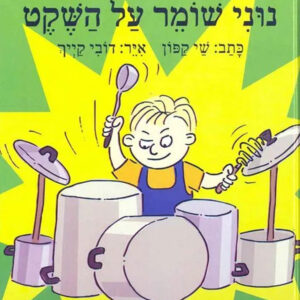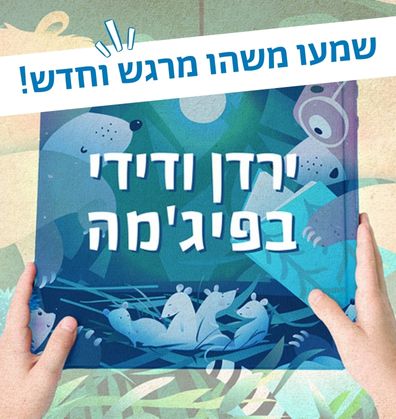הילד שנתן את העוגה והאיש שקיבל אותה אינם מכירים זה את זה. הילד נותן מִשֶּׁלּוֹ בלי שאיש יראה זאת, ולבסוף מקבל מתנה משמחת. איך קיבל את המתנה? מי שלח לו אותה?
נוֹשְׂאִים קְשׁוּרִים:
מעורבות חברתיתנדיבותערבות הדדית
קְבוּצַת גִּיל: גַּנִּים צְעִירִים
פְּעִילֻיּוֹת בְּעִקְבוֹת הַקְּרִיאָה
"המעגל הנסתר" הוא סיפור ללא מילים. האיורים של גיורא כרמי מכניסים אותנו אל עולם שלם שנמצא במרחב שבין הבית לספסל מולו. ילדיכם יכולים "לקרוא" את האיורים ולספר את הסיפור לפי הבנתם. קריאת סיפור על פי התבוננות בתמונות דורשת תשומת לב לפרטים ויצירת הֶקְשֵרִים (סגול בה"א) בתוך רצף התמונות. ספר מעין זה הוא הזדמנות ייחודית עבור הילדים לבטא את עולמם. תיהנו!
סְרָטִים בְּעִקְבוֹת הַסִּפּוּר
עֳתָקִים שֶׁחֻלְּקוּ:
45,000
הוֹצָאָה לָאוֹר:
כנרת
שְׁנַת חֲלֻקָּה:
תשע"א 2010-2011
הִמְשִׁיכוּ לִקְרֹא עִם סְפָרִים בַּנּוֹשְׂאִים קְשׁוּרִים:
שַׁלַּח לַחְמְךָ עַל פְּנֵי הַמָּיִם כִּי-בְרֹב הַיָּמִים תִּמְצָאֶנּוּ
שַׁלַּח לַחְמְךָ עַל פְּנֵי הַמָּיִם כִּי-בְרֹב הַיָּמִים תִּמְצָאֶנּוּ
בספר קֹהֶלֶת כתוב: "שַׁלַּח לַחְמְךָ עַל פְּנֵי הַמָּיִם כִּי-בְרֹב הַיָּמִים תִּמְצָאֶנּוּ" (קֹהֶלֶת יא, א). קֹהֶלֶת מתאר תמונה מעט דִמיונית של אדם שמניח את הלחם שלו במים, ונותן לו לשוט עם הזרם. לאן שט הלחם? מי מקבל אותו? אנחנו לא בדיוק יודעים. קֹהֶלֶת אומר כי ביום מן הימים האדם יקבל את שכרו על מה שנתן. "שַׁלַּח לַחְמְךָ עַל פְּנֵי הַמָּיִם" הפך לפִתגם שמשמעו: טוב לעשות מעשה טוב גם אם אנחנו לא יודעים בדיוק מי יהנה ממנו.
אפשר לבקש מהילדים להשוות את הבעת הפנים של הילד בעמוד הראשון של הספר
אפשר לבקש מהילדים להשוות את הבעת הפנים של הילד בעמוד הראשון של הספר, עם זו בסופו. על מה הוא מסתכל בכל תמונה? מה לדעתם גורם לחיוך הילד בעמוד האחרון של הספר? האם הילד מרגיש קשר בין הנתינה שלו בתחילת הסיפור, לבין החמנייה היפה שצמחה באדנית שלו?
מעגלי נתינה בגן
מעגלי נתינה בגן: הדגישו בפני הילדים את כל אותן הפעמים בהן הם עושים מעשים טובים, גם כשלא ברור מי יהנה מהם ובלי לצפות לקבל על כך תמורה מיידית.
מתן בסתר
מתן בסתר
הילד שנותן את העוגה והאיש שמקבל אותה אינם מכירים זה את זה, אבל הקשר ביניהם מניע את "המעגל הנסתר" של נתינה וקבלה. בספר דפוסים שונים של נתינה: נתינה גלויה וישירה, נתינה ללא ציפייה לתמורה, ונתינה שבה המקבל אפילו אינו יודע כי ניתנה לו מתנה. הרמב"ם פירט שמונה דרגות של נתינה. "מתן בסתר" היא אחת הדרגות הגבוהות ביותר: "וְלֹא יָדַע לְמִי נָתַן, וְלֹא יָדַע הֶעָנִי מִמִי לָקַח" (מִשְנֵה תּוֹרָה, מתנות עניים, י, ח). זאת כדי לא לבייש אף אחד.
אפשר להתמקד בתמונה בה הילד מסתכל על האיש שישן על הספסל. מה עובר בראש של הילד? בעמוד הבא רואים את העוגה מונחת על הספסל. איפה הילד בתמונה זו? למה הוא החליט להשאיר את העוגה? למה הוא לא חיכה עד שהאיש התעורר? האם הוא ציפה לקבל משהו בתמורה?
כִּי פָתֹחַ תִּפְתַּח אֶת יָדְךָ לוֹ
כִּי פָתֹחַ תִּפְתַּח אֶת יָדְךָ לוֹ
בספר דברים כתוב: "…לֹא תִקְפֹּץ אֶת יָדְךָ מֵאָחִיךָ הָאֶבְיוֹן, כִּי פָתֹחַ תִּפְתַּח אֶת יָדְךָ לוֹ…" (דברים טו ז-ח). יד קפוצה היא יד סגורה, ששומרת דברים ולא רוצה להתחלק בהם. לכל אחד מאיתנו לפעמים קשה לוותר ולהתחלק. אך התורה מעודדת אותנו לפתוח את היד כלפי אדם עני (אֶבְיוֹן), כדי לתת לו דבר שחסר לו.
תנו לילדים הזדמנויות "לפתוח את היד" ולתרגל עזרה לאחר! הספר מחולק לגנים לקראת חג פורים, בו נהוג לתת משלוחי מנות איש לרעהו ומתנות לאביונים. כדאי לחשוב על דרכים לקשר את הספר למנהגי החג בגן – בהתאם לגיל הילדים ואוכלוסיית ההורים. אפשר לחשוב על דרכים לציין "מתן בסתר" דרך חילופי משלוחי מנות איש לרעהו (אולי הגרלת משלוחי מנות, או משחק "גמד וענק"), וגם לאסוף מצרכים לנזקקים ולחלקם בקהילה כ"מתנות לאביונים".
מתן בסתר
מתן בסתר
הילד שנותן את העוגה והאיש שמקבל אותה אינם מכירים זה את זה, אבל הקשר ביניהם מניע את "המעגל הנסתר" של נתינה וקבלה. בספר דפוסים שונים של נתינה: נתינה גלויה וישירה, נתינה ללא ציפייה לתמורה, ונתינה שבה המקבל אפילו אינו יודע כי ניתנה לו מתנה. הרמב"ם פירט שמונה דרגות של נתינה. "מתן בסתר" היא אחת הדרגות הגבוהות ביותר: "וְלֹא יָדַע לְמִי נָתַן, וְלֹא יָדַע הֶעָנִי מִמִי לָקַח" (מִשְנֵה תּוֹרָה, מתנות עניים, י, ח). זאת כדי לא לבייש אף אחד.
חפשו יחד מקומות בסיפור שבהם מתרחשת נתינה
דפדפו עם ילדיכם וחפשו יחד מקומות בסיפור שבהם מתרחשת נתינה. מתי הנתינה גלויה ומתי היא "מתן בסתר"? שימו לב לשם הספר. למה לדעתכם בחר גיורא כרמי בשם זה?
מקדו את תשומת לבם של ילדיכם בתמונות המודגשות בצבע
מקדו את תשומת לבם של ילדיכם בתמונות המודגשות בצבע. למה לדעתכם בחר המאייר להדגיש דווקא אותן?
שחק עם ילדיכם במשחק "זהה את הרגש"
מאחורי הבעות הפנים בתמונות עומדים רגשות (לדוגמה: פני הילד המתבונן בזקן הישן, או פני הזקן כשהוא אוכל מהעוגה). כיצד מזהים רגש מתוך הבעות פנים?
תוכלו לשחק עם ילדיכם במשחק "זהה את הרגש". עשו פרצוף שמייצג רגש כלשהו ותנו לילדיכם לנחש את הרגש שמאחורי הבעת הפנים שלכם. אחר כך החליפו תפקידים ונסו אתם לזהות את הרגש שילדכם מציג.
חפשו בספר את התמונה שבה האיש העני מפורר מעט מהעוגה שלו עבור הציפורי
חפשו בספר את התמונה שבה האיש העני מפורר מעט מהעוגה שלו עבור הציפורים. בתלמוד אומרים החכמים: "אפילו עני המתפרנס מן הצדקה, יעשה צדקה" (גיטין ז, ב). מה יכול להיות ההיגיון במצווה זו?
המעשים הטובים נמצאים ממש בקרבתנו
"המעגל הנסתר" הוא סיפור על מעשי יום-יום, שקרובים לכל אחד מאיתנו. בספר דברים (ל, יד) נכתב על המִצְווֹת: "כִּי קָרוֹב אֵלֶיךָ הַדָּבָר מְאֹד,"כלומר, המעשים הטובים נמצאים ממש בקרבתנו. הם יכולים להיות גם דברים שילדים צעירים עושים. היזכרו יחד עם ילדיכם במעשים טובים שהם עושים (ובמעשים שהיו שמחים שמישהו היה עושה עבורם), למשל: לוותר על משחק בשביל חבר, לעזור לאחים או לילדים בגן…
ציירו מתנה מהסיפור
בסוף הספר מקבל הילד מתנה משמחת ומפתיעה. ציירו יחד חמנייה גדולה וצהובה. על כל עלה ציירו מתנה מהסיפור. האם לדעתכם מעגל הנתינה מסתיים עם צמיחת החמנייה בחלון של הילד? המציאו יחד המשך לסיפור וציירו אותו.

 החולם הקטן
החולם הקטן נוני שומר על השקט
נוני שומר על השקט
